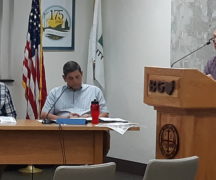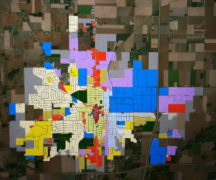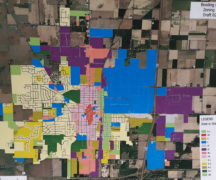As a member of Bowling Green City Council, I appreciate the citizens who have actively participated in the effort to update our zoning regulations. I’ve received a lot of valuable input and many diverse perspectives on how to best balance important considerations like preservation with the need to promote responsible growth and development. Participation in this effort demonstrates a strong commitment to the future of our city and the amended proposal before us is better for it.
Several questions regarding the proposed updates to our city’s zoning code were posed in letters to the editor submitted March 29 and April 13. These and similar questions have been echoed during lobby visitation at many of our recent meetings. Unfortunately, the conversation in that setting is, by design, one-sided; rather than a back-and-forth, our meetings are designed to give citizens an opportunity to speak at – not with – members of government. This is an important opportunity for citizens to voice their opinions and concerns, but it does not lend itself to a productive exchange of information between two or more parties. As a member of City Council, I believe we have a responsibility to be accessible and responsive, so I’d like to take this opportunity to provide my responses and hopefully clear up some of the uncertainty surrounding this issue.
I’ll attempt to address the questions from my point of view, but I also encourage interested parties to visit the following sources for additional information:
First, the City has a webpage dedicated to the years-long process to update our zoning code: https://www.bgohio.org/666/Zoning-Code-Update. There, you’ll find multiple planning documents spanning almost a decade that each involved community meetings, surveys, or other forms of public engagement. You can also view all 130 pages of the most recent draft of the zoning code, an interactive map, and past versions of the same documents.
Second, you can visit www.votejeffdennis.com/zoning for a variety of resources on the positive impacts of various zoning policies being considered. Topics include housing, sustainability, economic development, and diversity and inclusion. There are also links to case studies and other examples of communities that are addressing their own outdated land use policies.
Finally, you can visit Save Our BG Neighborhoods on Facebook for their version of the “Frequently Asked Questions” recently compiled by the City. This resource provides another unique perspective on the issue.
As a general matter, as our city continues to grow and evolve it’s important that we ensure that our land use regulations remain current and responsive to the needs of our community. Our current zoning code was adopted in 1975 and, by and large, still reflects the values and trends of that time. The effects can be seen all around us, including, for example, seas of half-empty parking lots lining the main thoroughfares into our community, a shortage of housing, and a market for outdated, “grandfathered” properties.
Though far from sufficient to address all the challenges Bowling Green is currently facing or will face in the decades ahead, the updates being proposed represent a good step forward in many respects. The proposed updates to these regulations are designed to promote responsible and sustainable development that reflects the values, character, and needs of our city today. They will help us strike a balance between preserving the unique character of our neighborhoods, improving access to safer, more affordable housing, and relieving pressure on and helping to revitalize areas of our city that many would agree have been too neglected for too long. In short, these proposals will allow for the growth and development necessary to attract and retain young families, grow a stronger, more resilient local economy, and avoid stagnation which threatens existing homes and businesses.
1. Why was the proposed Pedestrian Residential District (PR) targeted for special rules which somehow do not apply to the entire city of Bowling Green?
More than any other area of the city, the proposals for this area – the neighborhood where I live – reflect what is already on the ground. These neighborhoods immediately surrounding our downtown are some of our oldest, most diverse. This area is home to many local businesses, e.g., those on Maple, Merry, Pearl, Gorrell, Grove, and many homes of various sizes. That shouldn’t come as any surprise. Zoning was not legal in the State of Ohio until 1919, and our first zoning regulations were not adopted until decades later. These neighborhoods developed organically and, for the most part, in the absence of any zoning regulations at all. As a result, you can find affordable starter homes nestled amongst 120-year-old mansions. The result is a resilient neighborhood that’s full of character and diversity and continues to evolve after more than a century. This exists in spite of our 1970s zoning policy, not because of it.
2. Why do we need to allow 80% or even 70% coverage of lots in the PR district?
It’s worth first noting that this will be further limited by a variety of factors, which is the case for many of these individual regulations. Rather than isolating any one, you need to cross reference and take them all into consideration in order to get an accurate idea of what the possibilities could be.
This is a bit easier with a whiteboard, but I’ll try to provide an example. Assuming a lot is 40’ wide and 100’ deep (the minimum size permitted here), that would be a total area of 4,000 square feet. 70% coverage would be 2,800 square feet – a monstrous structure of 5,600 square feet when you add a second story!
Not so. You also need to take into account the required 20’ front yard setback, 20’ rear yard setback, and 5’ side yard setbacks. The result is a buildable area of 30’x60’, or 1,800 square feet (45% lot coverage). Note that this includes not only the structure, but also any patios, decks, garages, pools, driveways, sidewalks, and other areas of gravel, pavers, or pavement. April 2023 Draft, Page 13.
So, why permit this degree of flexibility? Personally, I think the question when dealing with land use shouldn’t be “why should we permit it?” rather, “what justifies prohibiting it?” (and I think case law would support that). In any case, one reason for permitting greater lot coverage is that not everyone wants a giant yard to maintain no matter how pleasant it may be for passersby to look at. If a homeowner would prefer to use that land for a pool, a deck, an addition, or something else, I fail to see sufficient justification for denying them that right. Another reason is that the lower the maximum lot coverage the larger the lot needs to be to build a reasonably sized home.
Land is one of the single biggest factors affecting home price, so requiring large yards can drive up costs significantly. A third reason is that this is just one regulation amongst a long list of others that will apply to any given parcel (e.g., use, parking pad size and location, setbacks, noise, light, use).
3. Why do we need to allow more businesses in residential neighborhoods when we have empty storefronts on Main Street?
There are many reasons we should always be trying to make it easier to start and run a small business in Bowling Green. Our entire community benefits in a variety of ways from a strong ecosystem of small businesses. That includes businesses that are high-volume, high-revenue, well-financed, and/or those that will benefit from a high volume of foot traffic. It also includes small boutiques, art galleries, startups, microbreweries, businesses with limited capital, or even those that are struggling to make it in higher-cost areas and might wish to downsize rather than closing entirely.
Unfortunately, significant cuts have been made that will restrict this code significantly when it comes to permitting new local businesses. The only businesses currently being proposed as “permitted” for the PR District (vs. “conditional,” meaning they cannot open if they would negatively impact the surrounding area, e.g., more traffic, noise, unreasonable hours of operation, etc. – for enumerated factors, see page 100) are (1) adult care facilities; (2) bed and breakfasts; (3) group homes; (4) professional offices (e.g., lawyer, accountant); and (5) trailer or subdivision sales (e.g., a model home). See April 2023 draft, Page 44.
4. Why do we need to allow more two-unit dwellings in neighborhoods that are already home to numerous non-conforming duplexes, triplexes and multi-unit buildings?
The premise seems to be that permitting new units will necessarily lead to a net increase in the total number of units. Another assumption seems to be that these homes are bad for our neighborhoods, per se. Both are oft repeated, neither is axiomatic.
Permitting the development of new, smaller housing units is beneficial for many reasons. First, smaller units are more affordable. Not everyone wants or can afford to maintain a large yard or an entire home. These families should not be limited from certain neighborhoods. Doing so has the effect of excluding families who cannot afford to rent an entire home. As it happens, the desire and tendency of exclusionary zoning to exclude “others” is well-documented. For decades, this was seen as a feature, not a bug. Surely, we’ve come a long way since then.
Second, two-unit dwellings can be a great intermediate step between renting and homeownership or homeownership and downsizing later in life. Smaller families in either situation could benefit from the ability to subsidize their mortgage payment and/or household expenses while monetizing un- or underutilized areas in their dwelling.
Third, providing flexibility and permitting the development of new housing will give renters more options and increase competition in our existing rental market. This would make it less profitable to rent an outdated or rundown property and create an incentive to either invest in improvements, lower prices, and/or place the house on the market for a homebuyer.
5. Why are there no City inspections of rental properties? And why are there no appropriate fines for non-compliance?
We should be more proactive with our enforcement. I wish we’d had this level of public outcry when that issue was being debated: https://bgindependentmedia.org/councilman-jeff-dennis-current-rental-inspection-ordinance-misses-the-mark/
6. Why are some cherry-picked comments from a document compiled in 2018 more important than what current residents want today?
Without knowing which comments are being referenced, it’s difficult to answer this question. Generally speaking, these policies will have an enormous impact on the way our community develops, but that impact will be felt in 2075, not 2025. For the first 100+ years of our history, we permitted organic growth and diverse, walkable neighborhoods (though that was out of necessity at the time). For the last 50 years, the trend has been auto-centric development with large parking lots, big box stores, and large subdivisions. Reasonable minds can disagree on what the next 50 should look like, but residents I talk to – young and old – seem to favor the former when presented with the facts.
7. Will residents of the blocks adjacent to the New Zone areas and business owners in the New [Mixed-Use Neighborhood] Zone be consulted prior to its adoption?
The uses proposed for the Mixed-Use Neighborhood (MUN) are less “intense” than what has been permitted there for decades. Currently, these areas – which have existed for many decades throughout our entire city – permit uses that I do not consider to be “neighborhood-scale.”
Examples include Hotels, which are currently permitted on parts of North Grove; Household appliance manufacturing, which is currently permitted on North Maple; Bars or taverns, which are currently permitted on North Summit; and mobile home parks, which are currently permitted on South Maple. Each of these uses is permitted along parts of Pearl under our current zoning code. For a complete list, see §§ 150.28, 150.29, and 150.35 of the current code: https://codelibrary.amlegal.com/codes/bowlinggreen_oh/latest/bowling_oh/0-0-0-12353. Each property owner in these areas bought their property with notice of and subject to these commercial parcels.
8. The New Zone will allow restaurants, bars and hotels among the zone’s residential areas. Will standards dealing with noise, signage, landscaping, screening, green space and business hours of operation be included?
Hotels, bars, and restaurants are already permitted in many of these areas and have been for decades (the exception would be areas zoned manufacturing which permit many uses that are arguably even less neighborly). The fact that many are not aware of this without checking our current Code suggests that perhaps there is not much cause for concern now. In many cases, it simply doesn’t make sense to open a business this large and costly in an area with a low average daily traffic count.
Every parcel is regulated in multiple ways, including noise, signage, setbacks, etc. In many ways – e.g., moving bars from “permitted” to “conditional” – we are increasing the regulations on these businesses in these areas.
9. How does allowing only two-story homes or multi-unit rental properties in the New [Mixed-Use Neighborhood] Zone meet the need for more owner-occupied affordable housing?
Not every action we take addresses every need we have, but the proposals before us are steps in the right direction in several respects. First, one-unit dwellings are not currently permitted in these areas at all. The proposals before us would add single-family homes as a permitted use.
Second, the cost of land is one of the single biggest factors affecting home price. The more of it you need to buy, the more you need to charge to break even. Reducing lot sizes and otherwise providing more flexibility will reduce the cost of building and create opportunities to build housing at a more affordable price.
For these reasons, I’m happy to concede the point on the height minimum and will be proposing an amendment that eliminates it from the final draft.
10. Councilman Dennis referred to “the key stakeholders” when talking about the New [Mixed-Use Neighborhood] Zone at the public forum on March 23. Who are the key stakeholders and how does City Council and the city administration prioritize them?
I can’t speak for my colleagues, and I suspect you’d get seven different answers to this question. In my opinion, it’s important anytime we make any decision that we make a concerted effort to hear from as broad and representative a sample as possible. That’s particularly important for a decision such as this which has the potential to either positively impact the trajectory of our community or ensure that we remain stagnant while other cities outperform us in the decades to come.
On this issue, there are many stakeholders who I think should be considered. That includes a broad range of residents, business owners, community organizations, developers, city officials, and many others who will be impacted directly or indirectly.
In my view, it’s not so much a question of “prioritization” as much as making sure I’m hearing from as broad and representative a sample as possible. I have a responsibility to consider the needs and perspectives of all stakeholders when making decisions, which includes those who can attend regular meetings and make their voices heard as well as those who might have soccer practice, exams, homework, or any number of other things that prevent them from attending various public meetings at 7:00 on a weeknight. It’s sometimes difficult to gather input from those in the latter camp, but I don’t think that makes their views and preferences any less relevant to the discussion.
11. The 2018 Community Action Plan includes a goal for the zoning update of maintaining traditional neighborhoods. How do the radical changes proposed for the PR District advance this goal?
A more specific citation is needed. I don’t think the Community Action Plan includes this goal. I welcome any evidence to the contrary – the document can be found here: https://bit.ly/3AmE0Hf.
The changes being proposed are not radical. We already have businesses, diverse lot and home sizes, and families of every size and type in my neighborhood. This makes the neighborhood more, not less, desirable.
Finally, I reject the view of a “traditional neighborhood” as one that is exclusively single-family homes. Zoning was not legal in the State of Ohio until 1919. Our current regulations were not adopted until 1975. Why is a “traditional neighborhood” one based on the standard in 1975 and not, for example, 1950? 1925? After all, my home and most of the other homes and businesses here in the heart of the PR District were built circa 1900. The traditional neighborhood is a walkable one built to human scale with a variety of gathering places and diversity of homes and uses. This code will permit that type of development again, though on a far more limited scale.
12. The draft code states that legal nonconforming uses may continue. How will the city deal with the many single-family homes that have been turned into illegal non-conforming multi-unit dwellings?
An entire chapter of the proposal before us deals with this issue. See page 93 of the April 2023 Draft.
13. Regarding Accessory Dwelling Units (ADUs), how will owner-occupancy be monitored and enforced?
For the first time in our city’s long history, owners of rental properties are required to register each unit and report changes in status to the City. Zoning is not a silver bullet and citizens should continue to be vigilant when it comes to making sure whatever we adopt – zoning or otherwise – is adequately enforced.
14. Isn’t a new housing development like the one proposed at Brim and Newton Roads an ideal location for the type of mixed-use “walkable” zoning that the PR District and New Zone call for?
One of our strongest assets is our downtown. More people living in and around downtown Bowling Green means more customers within walking distance from many of our local shops, restaurants, and other small businesses located there.
That being said, yes, in my opinion, relaxed zoning regulations that make it possible to build today the same type of walkable neighborhoods we built 100+ years ago and continue to celebrate today should be the norm. These proposals aren’t perfect, but they’re a step in that direction.
Jeff Dennis
Bowling Green City Council At-Large




